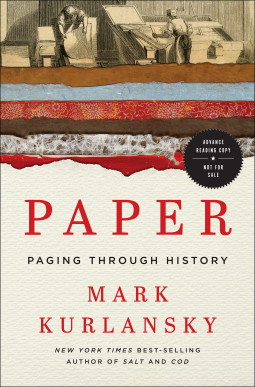
Paper
Paging Through History
by Mark Kurlansky
This title was previously available on NetGalley and is now archived.
Buy on Amazon
Buy on BN.com
Buy on Bookshop.org
*This page contains affiliate links, so we may earn a small commission when you make a purchase through links on our site at no additional cost to you.
Send NetGalley books directly to your Kindle or Kindle app
1
To read on a Kindle or Kindle app, please add kindle@netgalley.com as an approved email address to receive files in your Amazon account. Click here for step-by-step instructions.
2
Also find your Kindle email address within your Amazon account, and enter it here.
Pub Date May 10 2016 | Archive Date Apr 30 2016
Description
Paper is one of the simplest and most essential pieces of human technology. For the past two millennia, the ability to produce it in ever more efficient ways has supported the proliferation of literacy, media, religion, education, commerce, and art; it has formed the foundation of civilizations, promoting revolutions and restoring stability. One has only to look at history’s greatest press run, which produced 6.5 billion copies of Máo zhuxí yulu, Quotations from Chairman Mao Tse-tung (Zedong)—which doesn’t include editions in 37 foreign languages and in braille—to appreciate the range and influence of a single publication, in paper. Or take the fact that one of history’s most revered artists, Leonardo da Vinci, left behind only 15 paintings but 4,000 works on paper. And though the colonies were at the time calling for a boycott of all British goods, the one exception they made speaks to the essentiality of the material; they penned the Declaration of Independence on British paper.
Now, amid discussion of “going paperless”—and as speculation about the effects of a digitally dependent society grows rampant—we’ve come to a world-historic juncture. Thousands of years ago, Socrates and Plato warned that written language would be the end of “true knowledge,” replacing the need to exercise memory and think through complex questions. Similar arguments were made about the switch from handwritten to printed books, and today about the role of computer technology. By tracing paper’s evolution from antiquity to the present, with an emphasis on the contributions made in Asia and the Middle East, Mark Kurlansky challenges common assumptions about technology’s influence, affirming that paper is here to stay. Paper will be the commodity history that guides us forward in the twenty-first century and illuminates our times.
Advance Praise
"Kurlansky’s work makes brilliant use of paper as a key to civilization." - Booklist, Starred Review
"Kurlansky’s work makes brilliant use of paper as a key to civilization." - Booklist, Starred Review
Marketing Plan
ALA Midwinter appearance.
ALA Midwinter appearance.
Available Editions
| EDITION | Other Format |
| ISBN | 9780393239614 |
| PRICE | $27.95 (USD) |
Links
Featured Reviews
 Holly W, Educator
Holly W, Educator
Who knew that an everyday item such as paper could have such a rich and engaging history? I can't believe I enjoyed this book as much as I did. I think Kurlansky's topic is unique and would be an excellent and unique read for a class on the philosophy of history and historiography, as undergraduate students have a tendency to view history as focused on events rather than inventions. This was well worth the read!


















